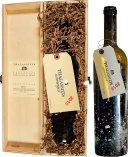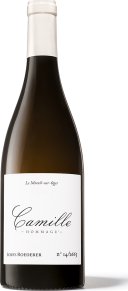$100 and over
Savaterre Chardonnay
Sourced from dry-grown, hand tended vines in the north east of Victoria, this Beechworth Chardonnay from Savaterre will surely convince even the most hardened Chardonnay critic that modern Australian Chardonnay is of supreme world-class standard. Keppell Smith handcrafts a Chardonnay of utmost power and concentration that produces a length of flavour that borders on the immortal.
Chateau d'Yquem
The harvest began very early, on the 5th September, and lasted 9 weeks. This made is possible to reflect all the diversity of a year in which both flowering and veraison were very spread out. Picking began especially early at Yquem in 2014. Some 25% of the crop was brought in before the 15th of September, providing a rare and precious background of acidity.
Domaine Faiveley Corton-Charlemagne Grand Cru
Penfolds Yattarna Chardonnay
Penfolds Yattarna Chardonnay displays an initial bouquet of slate and wet stone, with nuances of lightly roasted almonds. Subtle hints of citrus, shrouded by nectarine and nashi pear fruits. On the palate, a spiced multi-citrus compote with a very delicate acidity. Balanced and will develop exceptionally well with cellaring.
Trimbach Cuvee Frederic Emile Riesling
TRIMBACH Cuvee Frederic Emile Riesling, Ribeauville
Lake's Folly Chardonnay
One of Australias greatest examples of Chardonnay. This wine presents an intensely peachy, apricot laced nose with some cream, butterscotch, toast, nuts & orange blossom. Crisp, rich & full-bodied, a racy citrusy character comes through on the palate complimenting the stone fruits. The finish is long & leesy. 95 Points | James Halliday.
Gaia Thalassitis Submerged Assyrtiko
Located on the east side of Santorini island between Kamari and Monolithos hamlets, Gaía Winery is a beautiful example of the rich history of the area. The building, which was once a tomato factory from the early 1900s, has been restored with love and transformed into a cutting-edge winery. GAIA takes pride in preserving their heritage, and the industrial stone building is a perfect example of this. Gaía's state-of-the-art equipment and facilities provide ideal conditions for producing high-quality wine. At Gaia Wines, the founders, Yiannis Paraskevopoulos and Leon Karatsalos, embody the Greek spirit of travel and lifelong learning. Their expertise in agriculture and enology has allowed them to create wines that speak to the ancient secrets of the Greek land. The Ammonite symbol, a fossil from the Aegean Sea, has become a symbol of their brand, representing their commitment to exploring the depths of Greek terroir. Gaía's Agiorgitiko and Assyrtiko wines have travelled the world, carrying the name of Gaia Wines with them. They strive to offer wine lovers the best possible experience, each in their unique way. Santorini boasts a quintessential Mediterranean climate, characterized by warm temperatures, low rainfall and high humidity during the growing season. However, the area is also prone to strong winds coming off the ocean, which can pose a threat to the vines and grapes if they are not trained low to the ground for protection. Adding to the challenge, the vineyard soils of the region are notoriously poor, composed of volcanic ash and rocks. Nevertheless, the calcareous subsoils are porous, which helps to retain some of the humidity in the air and release it as moisture in the night for the vines to use. One of the standout grape varieties of the region is Assyrtiko, a classy white grape that is possibly one of the greatest varieties found in the Mediterranean basin. Originating from Santorini, it has since spread all over Greece and become one of the most important native varietals in terms of quality. Assyrtiko mainly produces dry white wines, some of which are aged in oak, but a number of sweet wines are also made from sun-dried grapes. A unique and special aspect of vine pruning on Santorini is the Santorini “kouloura,” also known as the “wreath” or “basket” method. The origins of this technique are lost in time, but it has been perfected to such an extent that it not only provides the most suitable way of training the vines but also gives them the appearance of natural works of art. Since 2009, Gaia has been submerging approximately 500 bottles of their Thalassitis off the east coast of Santorini each year. The wines are left to age in the depths of the ocean under exceptional conditions of stable temperatures, away from light and unaffected by oxygen. At 20 meters deep, an underwater cellar is formed, which at any given moment hosts four consecutive vintages of Thalassitis. The first attempt in 2009 saw only three bottles returned to the surface fully intact. Subsequent attempts with the 2010 and 2011 vintages saw 258 and 141 bottles survive, respectively. Unfortunately, the depth of 30 meters proved too ambitious, and the high pressure damaged the majority of the bottles from both the 2012 and 2013 vintages. Following these challenges, the winery adjusted the depth of submersion and the corks used, resulting in better-than-expected outcomes. The 2015 and 2016 vintages respectively “returned” 407 and 497 intact, incredible bottles. As with every past vintage, the outcome of the four-year-long stay in the underwater cellar is impressive. The outcome of the four-year-long stay in the underwater cellar is truly impressive, as with every past vintage. Thalassitis Submerged wine has a unique smoky aromatic dimension and a hydrocarbon note that gives it a rounder and evolved impression. Despite its misleading youth in colour, there is no sign of oxidation. This rare "hybrid" wine balances between youth and maturity, offering a bone-dry taste, strong character and a full-bodied, well-structured mouthfeel with crisp acidity, distinctive minerality and delicate honeysuckle aromas. To fully appreciate the wine's depth and complexity, it is best to decant it for 30 to 60 minutes before serving. Thalassitis Submerged pairs well with seafood, fish, shellfish, or even lamb stewed in lemon sauce, generally with flavours of moderate intensity where salt, sour or oil predominate. The wine has a medium golden colour and a nose that testifies to its marine origin. Intense aromas of petrol, grapefruit, citrus, lemon, honey and peach, dressed with sea breeze notes, create a unique and unforgettable experience. The mouthfeel is shockingly dense and expressive, with a rich body and sharp acidity. With just one sip, the whole range of yellow and green citrus fruits, along with generous doses of wet stone and smoke, are spread on your palate. In 2018, the vintage was characterized by extremely condensed wines, with very high acidities and incredible structure due in part to the extremely low yields. The relatively cool temperature of the days of harvest gifted the wines with bright and fresh aromas of citrus, stone fruit, tropical fruit, and white flowers that were more intense and complex than usual.
Louis Roederer Hommage à Camille Coteaux Champenois Blanc
Camille was the ingenious widow at the helm of Louis Roederer from 1932 to 1975, successfully steering it through all the important events of that time. Camille had many strong cards up her sleeve: wines from the finest Champagne terroirs, a collection of crus that her husband Léon had shrewdly acquired after the phylloxera crisis. These exceptional plots in Aÿ, Avize, Cramant, Le Mesnil-sur-Oger, Mareuil-sur-Aÿ and Cumières are the treasure troves and foundations of Louis Roederer’s unique style. Their still red and white wines are an authentic expression of the Champagne terroirs that Camille held so dear. Frédéric Rouzaud wanted to pay homage to the great-grandmother whose playful spirit he had so admired. He therefore decided to dedicate this collection of single-vineyard still wines to Camille, perpetuating the Champagne House’s inventive spirit. This new collection is the result of a twofold motion; a glance backwards, to the past, in homage to ancestor Camille; and a gesture to the future, to that which Nature offers and to receive it in order to render it even more beautiful. By working closely with the vines, using solar viticulture and bespoke vinification, they are able to reveal a new dimension hidden in their champagne terroirs. To craft this Chardonnay single-vineyard white wine, the team at Louis Roederer needed to find the most suitable hillside that would give an elegant wine with depth, structure and great style. Volibarts, the historical 55-ares, southeast-facing plot in Le Mesnil-sur-Oger, where the old vines grow gently and slowly, seemed to be the ideal choice. Their quest for complexity and a certain tannic character can only be achieved through bespoke vinification. This Chardonnay strikes just the right balance between depth and purity, resulting in a sophisticated composition that draws itself out with exceptional freshness. The 2020 season followed a similar trajectory to that of 2019: a mild, wet winter followed by a dry summer with several heatwaves, admittedly less extreme than in 2019, but which had an impact on the vines. Fortunately, a rather dull month of June brought us a wet interlude between two dry periods. Despite the hot spells and the impression of constant sunshine, the 2020 campaign ended up with relatively normal temperatures and sunshine levels. These continental weather conditions, but with “normal” annual averages, allowed us to produce ripe and well balanced wines. Deep golden yellow hue. Bouquet of yellow fruit (Mirabelle plums), dried nuts (almonds), wheat and roasted hazelnuts. The oaky notes are delicately interwoven into the wine's bouquet, giving an impression of a delicious, noble reduction. The palate is concentrated and caressingly soft with a big, rich, rounded and oily texture. The mid-palate reveals a delicate, sappy texture combined with the lovely mineral acidity that is the hallmark of this wine, while the texture of the oak lengthens the palate and creates a very savoury finish. Oaky notes delicately interwoven into the wine's bouquet, giving an impression of a delicious noble reduction.
Joh jos prum Wehlener Sonnenuhr Riesling-Spatlese
Named of the sundial erected in the vineyard in 1842, Wehlener Sonnenuhr is the most famous vineyard in the Mosel. Extremely steep with optimal south-south west exposure, it yields fragrantly floral wines with ripe stone fruit aromas, underlying slately minerality and wonderful depth of flavour and structure. The Spatlese wines are very reticent in youth, blossoming between two and four years of age to display vibrant green apple, and white stone-fruit notes supported by a backbone of racy acidity.
Domaine Chanson Savigny-Les-Beaune Hauts Marconnets 1er cru Blanc
Domaine Chanson Savigny-Les-Beaune Hauts Marconnets 1er cru Blanc 2018 is a beautiful gold colour. Floral fragrances mixed with expressive aromas of citrus fruit on a smoky hint. Complex with a good balance. Tight texture. Long and refreshing finish with a hint of minerality. White wines are very unusual in Savigny-les-Beaune, the vineyards producing essentially red wines. The particular nature of the soil "Hauts Marconnets" with Marl, chalk and limestone encouraged Chanson to plant Chardonnay. The vineyard of 2,18 hectares is ideally situated high up on the hill of Savigny-les-Beaune, facing south-east, close to the hills of Beaune 1er Crus. After a rainy winter, spring started with a very warm episode in April followed by very cold temperatures in May. The warm weather settled down early June. The summer was punctuated by several heat waves which engendered a lack of water, compensated by the presence of clay in many plots. The harvest started end of August, in outstanding conditions with grapes fully ripe and healthy. The white wines are precise with a beautiful fruit combination. After a mild pressing, this wine was vinified and aged for 12 to 14 months in oak casks in our cellars of the. Moderate proportion of new oak.

































